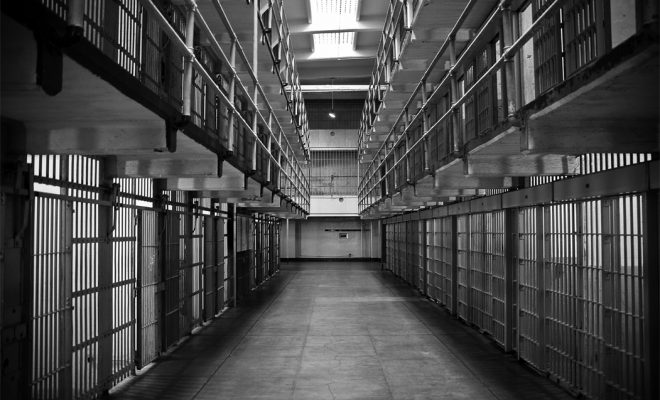 "Lockdown B&W" Courtesy of [Krystian Olszanski via Flickr]
"Lockdown B&W" Courtesy of [Krystian Olszanski via Flickr]
Law
Mass Incarceration: Why Are There So Many Women Behind Bars?
With the United States locking up more people every year, prison reform is a topic of national concern. The impacts of mass incarceration on communities and families have become an epidemic, one with lasting consequences. Jails are overcrowded–filled to the brim with non-violent offenders–even as rates for more serious crimes have declined. The number of women in jail is growing at a faster rate than men, according to a new report published by the Vera Institute for Justice and the Safety and Justice Challenge. Entitled “Overlooked: Women and Jail in an Era of Reform,” the research is unique and necessary, as most of the existing information on the criminal justice system focuses specifically on men.
HISTORY OF WOMEN BEHIND BARS
Jails are confinement facilities, run by counties or municipalities that hold people accused of a crime while they await case resolution. Over the past forty years, the number of people behind bars in the U.S. has increased five-fold. On any given day in 1970, there were 157,000 people in jail; in 2014, that number rose to 745,000. Now there are more than 11 million admissions annually. Jails have been transformed from housing extremely dangerous individuals to keeping those too poor to post bail or too sick for assistance in the jail system. Life challenges such as unemployment, extreme poverty, physical and behavioral struggles, substance abuse, and mental health issues plague many women in jail.
Around 1970, there were only 8,000 women in the jail system. Now, with nearly 110,000 women behind bars, they are the fastest-growing incarcerated population in the U.S. Women are now held in jails in nearly every county in the country, in stark contrast to 1970 when roughly three-quarters of counties held not a single woman in jail. Women can find themselves involved with the criminal justice system because of poverty, mental and behavioral health issues, substance abuse, or a history of trauma.
The majority of women behind bars are there for non-violent crimes, which amounts to roughly 82 percent according to the last batch of national data from nearly a decade ago. A survey from Davidson County, Tennessee revealed that 77 percent of women in the jails were charged with a misdemeanor. Moreover, women are not necessarily committing new offenses. More recent research has found that women are more likely to be in jail for breaking a condition of supervision in the community, like failing a drug test or missing an appointment with a probation or parole officer.
GEOGRAPHIC INCREASES
Small counties, with less than 250,000 people, are seeing the largest increase in jailed women. In 1970, these same counties had just 1,700 incarcerated women compared to 51,600 by 2014. Sparsely populated counties see an incarceration rate of 140 per 100,000 women. Using 2014 data, the Vera Institute found that on a typical day large counties had an average of 271 inmates per 100,000 people versus 446 inmates in rural counties.
This is in stark contrast to another trend, which shows a declining rate of incarcerated women in the nation’s largest counties. The trend is illustrated in counties like Stokes County, North Carolina, where women made up 32 percent of the jailed population in 2013, far beyond the national average. Data is still unclear as to why jail populations have increased so significantly in rural areas. Research notes that it could be the demographics of rural and suburban areas, which tend to house poorer populations.
!["Handcuffs" Courtesy of [davitydave via Flickr]](http://lawstreetmedia.com/wp-content/uploads/7340186858_6b5af01909_o-320x240.jpg)
“Handcuffs” Courtesy of [davitydave via Flickr]
PREVALENCE OF HEALTH ISSUES IN INCARCERATED WOMEN
Research has also noted that a number of women behind bars suffer from health issues, particularly mental illness. Thirty-two percent of women in U.S. jails have a serious mental illness, including major depression, bipolar disorder, and schizophrenia. According to the Bureau of Justice Statistics, 75 percent of women in jails stated they had symptoms of a mental health disorder in the past year. This high percentage of serious mental illnesses among incarcerated women is intimately tied to the high rates of victimization reported: sexual assault, intimate partner violence, and childhood sexual abuse. The numbers are startling. Based on the research among women in jail, 86 percent report experiencing sexual violence, 77 percent report partner violence, and 60 percent report caregiver violence.
The complexity of mental illness means many incarcerated women are unable to receive effective assistance. One in five women in U.S. jails has experienced a serious mental illness, post-traumatic stress disorder, and substance abuse disorder. This staggering number is met only with limited mental health care professionals and resources in the jail system. With a distinct lack of proper tools and support systems, many incarcerated women never have their severe mental health issues addressed.
WOMEN OF COLOR IN JAIL
For both men and women, people of color are disproportionately incarcerated. According to the most recent national data, roughly two-thirds of women currently behind bars are women of color. Forty-four percent were black, 15 percent were Hispanic, and five percent were of other racial and ethnic backgrounds, with only 36 percent of incarcerated women identifying as white. At a county level, the racial and ethnic disparities are even larger. In Cook County, Illinois, approximately 81 percent of women admitted in the jails were women of color.
Women of color are far more likely to experience financial instability and crisis, even before they enter a jail. Nearly half of all single black and Hispanic women have zero or negative net wealth, with black women five times more likely to live in poverty and receive public assistance. Staying in jail for even a short period of time can severely impact their basic survival needs, like suspension or even termination of public assistance.
INCARCERATION IMPACTS ON WOMEN
Women are heavily affected by jail, as the environment is often not designed for their specific needs and experiences. Women are assessed with the same assessment tools for men to determine where and how they are housed within facilities. Using a gender-neutral or male-focused tool ignores the research that shows women tend to pose less risk than men. As a result, the tools can classify women at a higher risk than they actually are, with over-classification barring them from educational, vocational, and rehabilitative programs.
Reproductive health needs are also a crucial issue for incarcerated women. Many jails fail to even meet basic hygiene needs for women. Muskegon County Jail was sued in 2014 by the ACLU of Michigan for failing to provide women menstrual hygiene products, toilet paper, and clean underwear. Other women in jails have reported being unable to receive hygiene products on a certain day because they are unavailable or only provided selectively. The health risks and emotional humiliation these policies create have caused some positive policy changes, like efforts to make free supplies readily available to incarcerated women.
WHAT DRIVES THIS GROWTH?
Shifts in police policy and enforcement over the decades contributed to a rising number of arrests of women. One particular policy departments embraced was “broken windows” policing; this policing theory focuses on low-level offenses like petty theft, loitering, and intoxication as a way to prevent more serious crimes. Moreover, in the 1980’s and 1990’s, policing priorities were expanded with the national “War on Drugs,” which escalated the enforcement and criminalization of drug offenses. These policies worked in conjunction to widen police power and entrap more citizens in the jail system.
The increase in these practices, however, had significant impacts on women specifically. Women are more likely than men to be involved in minor offenses like drug possession. Between 1980 and 2009, the arrest rate for women tripled while the arrest rate for men only doubled. Currently, women are arrested more frequently for “other-except-traffic” offenses, which includes activity such as criminal mischief and local ordinance violations, substance use, minor property crimes, and simple assault.
Another example of certain policies increasing the number of women in jail are prostitution diversion programs, which are present in many of the largest U.S. districts. These services may end up bringing more women into contact with the criminal justice system, particularly women of color and transgender women. Many jurisdictions use practices similar to drug stings to curb prostitution. Officers do targeted sweeps of specific neighborhoods and communities that may have high rates of prostitution. Police then may make arrests based on subjective characteristics or observations, such as walking or standing in a particular area or carrying condoms. This practice may be treating prostitution defendants as both victims and offenders, and creating an arrest record for women that can make life outside of the justice system and sex trade difficult to achieve.
CONCLUSION
Incarceration has become common practice in the U.S. for even the smallest, most non-violent of offenses. Considering the profound consequences staying in jail for even a few days can have, time in jail may be more effective when used only for dangerous offenders. Women, particularly women of color, have been a rising target of the criminal justice system for decades now. With current practices and rehabilitative efforts, it is clear that substantive change is needed.
Many questions remain about women in jail. The lack of current, comprehensive research on female incarceration impacts demonstrates a gap in addressing the rising number of jailed women. Reforming the U.S. jail system is within our grasp, if we take the reins and embrace positive, meaningful policy changes.
RESOURCES
Primary
Safety Justice and Challenge: Overlooked: Women and Jail in the Era of Reform
Bureau of Justice Statistics: Mental Health Problems of Prison and Jail Inmates
Additional
New York Times: Number of Women in Jail Has Grown Faster Than That of Men, Study Says
Washington Post: How Mass Incarceration is Spreading to Rural Counties and the Suburbs
NPR: Study: The Growing, Disproportionate Number Of Women Of Color in U.S. Jails
ACLU: Facts about the Over-Incarceration of Women in the United States
The Sentencing Project: Incarcerated Women and Girls
Center for Court Innovation: Prostitution Diversion Programs








Comments